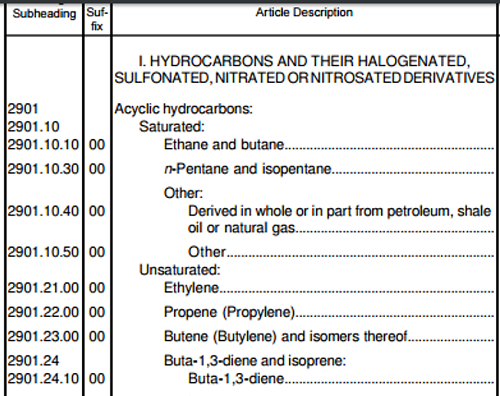How to Determine HS Code for Chemicals
Little Pro on 2017-07-18
HS Code is also known as Harmonized System (HS) Commodity Code. It is a system developed by the World Customs Organization (WCO) to help national customs and statistical authorities classify commodities. Each commodity or product will be assigned with a HS code, which is then used by Customs authorities and statistical agencies to monitor and control the import and export of commodities through customs tariffs and the collection of info on international trade. In this article, we will summarize the structure of HS Code and show you how to determine HS code for chemicals.
Structure of HS Code
Most of countries use an 8-digit or 10-digit classification system, with the first 6-digit adopting the Harmonized System developed by the WCO and the last 2 or 4 digits representing a further breakdown in commodity classification to meet domestic needs. The Harmonized System (HS) comprises 21 Sections covering 97 Chapters. In each chapter, there are headings, sub-headings and notes for each heading and sub-heading.
The structure of an 8-digit or 10-digit HS Code is listed as follows:
- First 2 digits: Chapter No. from the Harmonized System
- Second 2 digits: Heading No. from the Harmonized System
- Third 2 digits: Sub-heading No. from the Harmonized System
- Last 2 or 4 digits: Domestic use identification number
The picture below is a screenshot of the HS codes for some common organic chemical substances listed in Chapter 29 Organic Chemicals.

Note: Different countries might assign different HS codes for the same product. However, the first 6 digits of a HS code for a product are usually the same since most of countries have developed their commodity classification system based on the Harmonized System (HS).
HS Code for Chemicals
Chemicals and chemical products are listed in the Section VI of the Harmonized System – Products of the Chemical or Allied Industries. There are 11 chapters related to chemicals and chemical products (Chapter 28 to 38). They are listed as follows:
- Chapter 28 Inorganic chemicals; organic or inorganic compounds of precious metals, of rare-earth metals, of radioactive elements or of isotopes
- Chapter 29 Organic chemicals
- Chapter 30 Pharmaceutical products
- Chapter 31 Fertilisers
- Chapter 32 Tanning or dyeing extracts; tannins and their derivatives; dyes, pigments and other colouring matter; paints and varnishes; putty and other mastics; inks
- Chapter 33 Essential oils and resinoids; perfumery, cosmetic or toilet preparations
- Chapter 34 Soap, organic surface-active agents, washing preparations, lubricating preparations, artificial waxes, prepared waxes, polishing or scouring preparations, candles and similar articles, modelling pastes, “dental waxes” and dental preparations with a basis of plaster
- Chapter 35 Albuminoidal substances; modified starches; glues; enzymes
- Chapter 36 Explosives; pyrotechnic products; matches; pyrophoric alloys; certain combustible preparations
- Chapter 37 Photographic or cinematographic goods
- Chapter 38 Miscellaneous chemical products
If you wish to see the quick break-down of each chapter above, you may go to http://www.foreign-trade.com. However, if you wish to read the notes for each chapter or (sub-)heading and confirm whether an HS code covers your product, you are recommended to consult national commodity classification handbook. Reading the US version of the Harmonized System is also good start.
How to Determine HS Code for Chemicals
Determining right HS Code for a chemical product is not as difficult as you think. You need to gather the following info as a minium requirement.
- Whether it is a substance or mixture? Inorganic substances and organic substances are usually classified in Chapter 28 and Chapter 29. Chemical mixtures are generally classified in Chapters 30 to 38 based on their intended usage. Impurties and stablizers can be considered as part of a substance.
- What is the intended usage of your product? For example, Chapter 30 pharmaceutical products, Chapter 32 paints. If you cannot find a perfect match for your mixture product from Chapter 30 to 37, please go to Chapter 38. For example, 38.08 covers pesticides and it can be further broken down to herbicides, insecticides, etc.
- Does your product belong to rubber or plastic or an article made of rubber or plastics? You may find them in chapter 39 and 40.
Important note: Notes for each chapter, heading or sub-heading are very important. The notes include definitions and clarifications of certain terms and products and also exclude some products. For example, the notes of Chapter 29 state that it does not cover ethyl alcohol (heading 22.07 or 22.08).
Note: Please subscribe to our newsletter to receive updates about new articles and tutorials.
Having Questions?
We do not provide consultancy services. If you have questions or need any help, please contact our sponsor. You may also find an expert in CSP business directory below. If you are a consultant, you may get yourself listed in CSP business directory (free) or sponsor this page to leave your contact info on this page..

Tags: Topics - Trade, Controlled Chemicals Trade